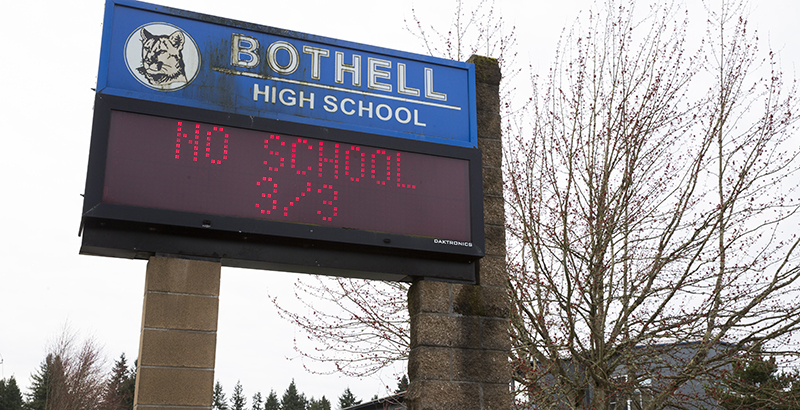Lake: As Coronavirus Forces Schools to Go Virtual, We Must Innovate — and Embrace Learning As We Go. How 1 Washington District at the Epicenter Is Doing Just That

I’m distressed that my hometown, Seattle, is ground zero for the U.S. outbreak of COVID-19.
I am heartened, though, by the fact that our community is primed to offer innovative responses, including in K-12 education.
As we face the prospect that the disease will spread in other parts of the country, it is imperative that we study those responses so other communities can learn from them.
Our city and its surrounding communities are rapidly shutting down, or, more precisely, moving to the cloud. On March 6, county officials advised people to work from home. Yoga studios are offering online classes. Food delivery services are offering meals with “no contact” between diners and delivery workers.
In an unprecedented move, the University of Washington — my organization’s institutional home — announced that classes and exams will move fully online for the remainder of the quarter.
The Northshore School District, a 30-minute drive from Seattle and smack in the middle of the outbreak, will go virtual for two weeks to help stop an epidemic.
In her letter to families, Northshore’s superintendent, Dr. Michelle Reid, demonstrated thoughtful and forward-looking leadership. She explained that the district would shift instruction “from the classroom to the cloud,” equipping all students with a device and a Wi-Fi connection.
She explained: “Education is a service to which our district is resolutely committed. It is not a place.”
To prepare for this radical transition, Northshore provided special training for teachers and students, made provisions for special education and is developing student support centers for families who need childcare.
Critically, planning began weeks ago, when news of the global outbreak was just starting to spread. By the time the first case emerged in Everett, a nearby city, on March 2, Reid knew she had to move quickly. She reorganized the district team to support remote learning.
The first step was to pull together an external leadership team to inform her vision for remote learning. She pulled together the district’s leadership cabinet and union heads to develop an implementation plan.
In an interview over the weekend, Reid said she had to rearrange her internal team around a new set of functions.
“If this kind of thing goes out to committees,” she said, “you freeze.”
The district team made sure someone returned every phone call within 30 minutes. They knew they need to be responsive to parents and their community. Someone had to manage all the technology. Someone had to coordinate with other local officials to help stage food deliveries for families in need.
The district closed school last Tuesday, March 3, to train teachers, all using the district’s internal expertise. It has a team of counselors who can visit students at home and a “social isolation” captain.
“We have 3,000 employees who are organizing to support every student,” Reid said. “We are going to make this work.”
The district hosted a webinar and had 2,500 parents join. It is offering training and tools to help parents support their kids at home.
To keep families informed, the district livestreamed a 30-minute meeting of its leadership cabinet so families could hear them updating one another and how they’re planning.
Northshore is a relatively wealthy suburb, with only 14 percent of its students eligible for free or reduced-price school lunch. It’s likely that most students already have access to technology at home and have parents who can support their online work. Still, this is a critical experiment to watch and learn from.
The district will arrange to lend technology (devices and hotspots) to students who don’t have them. It is working to solve for other challenges, including serving students with disabilities and limited proficiency in English (Northshore students speak more than 90 languages).
Many other school systems in Washington and around the world will soon face a similar emergency situation. It will be critical to learn what it takes to pull this off. What kind of training and support do teachers need? What can parents do at home? How can communities rally to provide additional support to students whose parents cannot stay home? What kinds of safeguards need to be put in place to make sure that students with unique needs don’t get lost in the shuffle? And what happens when life and classrooms return to normal?
Guidance from Washington State’s superintendent of public instruction urges districts to avoid moving to virtual schooling unless they are fully prepared to answer those questions.
I respect the sentiment, but many districts are paralyzed right now, faced with a choice of keeping kids safe or keeping them learning. Instead, they must prepare to do both.
As Reid put it, “I don’t want to engage in binary thinking.” Our schools must find ways to protect students and their communities from disease — and to minimize disruptions to the other vital services that schools provide, starting with instruction.
In other words, now is the time to innovate.
Going virtual might save lives. It also brings serious challenges. My organization, CRPE, will track these efforts and share lessons about managing these challenges quickly and broadly. What we learn in this crisis can help school systems respond to other disruptions in the future — whether due to weather, disease or other disasters.
These are surreal times in the beautiful Pacific Northwest. I’m thankful for the bold leadership of Reid and University of Washington President Ana Mari Cauce.
So many of our neighbors are sick, and too many lives have already been lost. The silver lining, however, is that the Northwest spirit of innovation and problem-solving remains healthy as ever.
Robin Lake is director of the Center on Reinventing Public Education at the University of Washington Bothell. You can find her on Twitter @RbnLake.
Get stories like these delivered straight to your inbox. Sign up for The 74 Newsletter

;)
